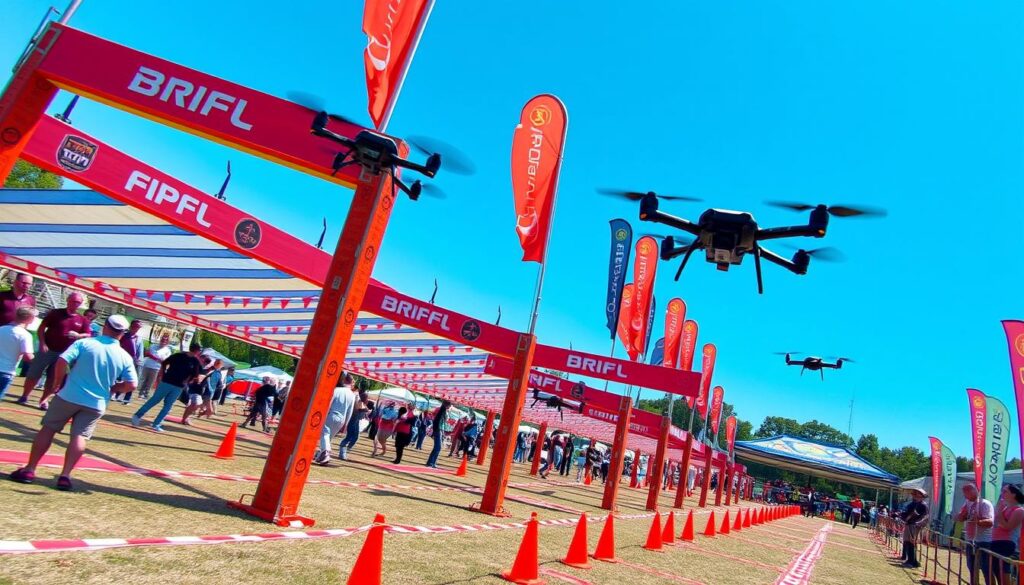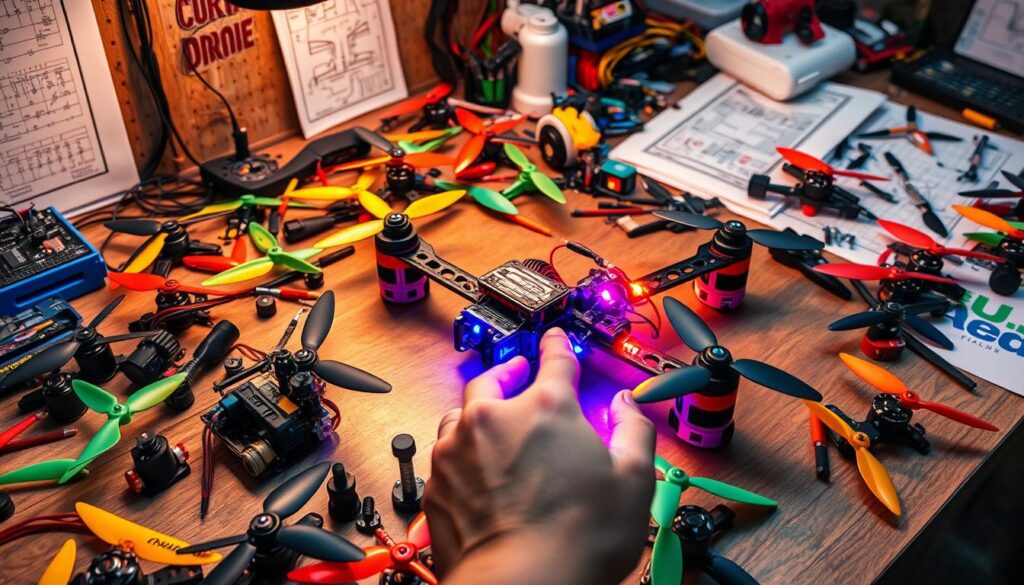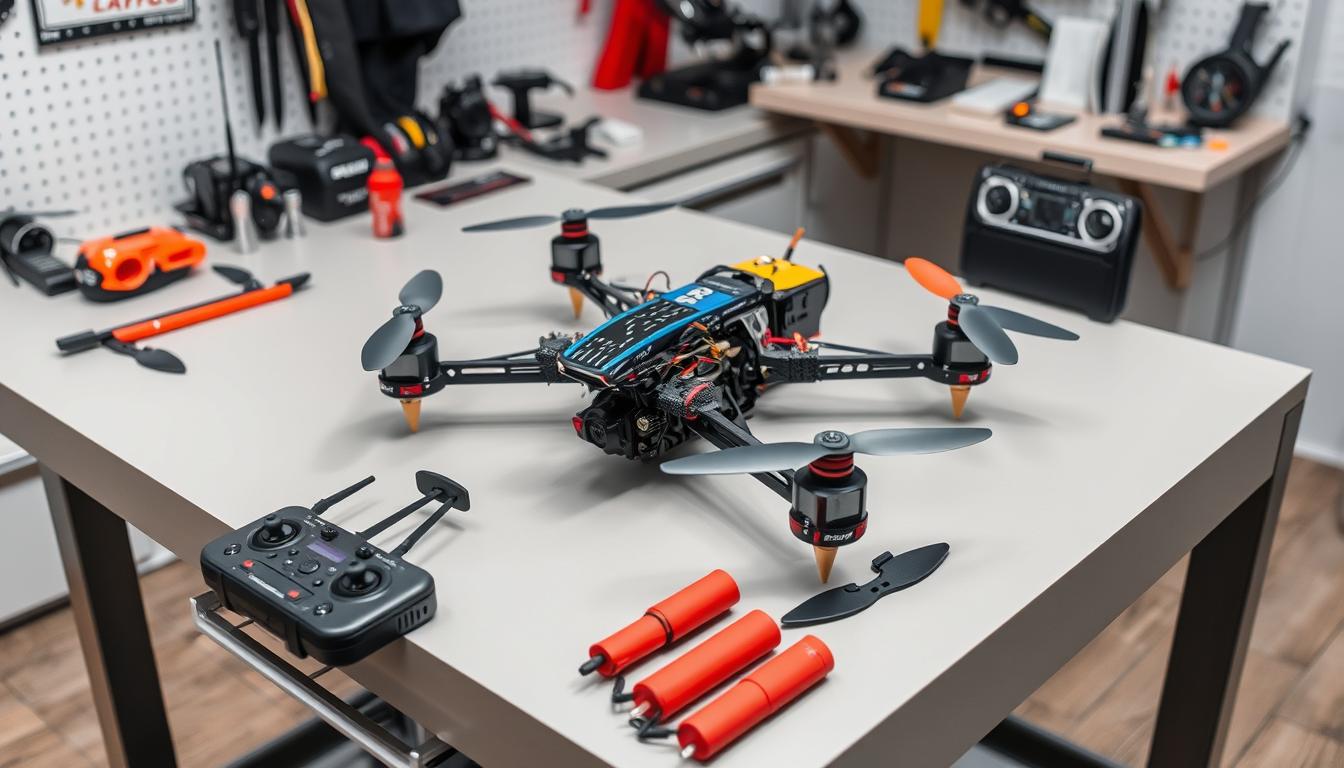Did you know that most drones used in FPV racing are quadcopters? They have four rotors for stability and speed. This makes them great for racing through tough courses.
FPV drone racing is getting more popular. But for beginners, it can feel overwhelming. We’re here to help you find the right gear and resources to start your FPV drone racing journey.
First, you need to understand the basics of FPV drone racing. It lets pilots see from a bird’s-eye view. This is thanks to the FPV system that shows real-time video. Whether you want to fly freely, race, or take photos, there’s a drone for you.
When picking your FPV drone racing gear, consider a few things. Your drone’s frame should be light but strong. The flight system, including the controller, motors, and propellers, affects how well it flies. Also, the power system, like the battery and power board, impacts how long you can fly.
Key Takeaways
- FPV drone racing offers an immersive, first-person perspective experience for pilots
- Essential FPV drone racing gear includes the drone, goggles, controller, transmitter, and batteries
- Understanding the basics of FPV drone setup, including flight system and power system components, is crucial for beginners
- Choosing between building your own drone or purchasing a ready-to-fly kit depends on your skill level and budget
- Mastering FPV drone flying techniques requires practice, learning from the community, and continuously improving your skills
Understanding FPV Drone Racing Basics
FPV drone racing has become a hit worldwide, thrilling both pilots and viewers. It’s key for beginners to learn the basics before starting.
What is FPV Drone Racing?
FPV drone racing lets pilots control a drone with a camera that shows live video. This view makes pilots feel like they’re in the cockpit. It’s both fun and exciting.
With over 60,000 drone pilots using Drone Pilot Ground School, its popularity is growing fast. They’ve passed the Part 107 test at a rate over 99%.

To control the drone’s height, pilots use the left stick. Pushing it forward goes up, pulling it back goes down. This skill is vital for racing and flying.
Before flying, pilots check the weather. It must be clear, with no rain, wind under 15 knots, and clouds above 500 feet. Visibility should be at least 3 miles.
Types of FPV Flying: Freestyle, Racing, and Photography
FPV flying has three main types, each with its own challenges and rewards:
- Freestyle: This style lets pilots explore and do tricks, showing off their creativity.
- Racing: In racing, pilots compete on courses, going fast and navigating obstacles. It needs quick reflexes and control.
- Photography: FPV drones are great for aerial photos and videos. It’s about flying smoothly and capturing the right shots.
Choosing any FPV flying type, quality gear and practice are key. With effort, you’ll soon enjoy the thrill of FPV drone racing.
Choosing Between Building Your Own Drone or Buying Ready-to-Fly
When you start with FPV drone racing, you have a big choice to make. Should you build your own drone or buy a ready-to-fly one? Each option has its own benefits, depending on what you like, your skills, and what you want to achieve.
Advantages of Building Your Own Drone
Building your own drone has many perks:
- Customization: Make your drone exactly how you want it
- Cost savings: It’s often cheaper than buying a prebuilt drone
- Knowledge and skills development: Learn a lot about drone parts and how they work
- Upgradability: You can change parts as you get better and want more
- Sense of accomplishment: Fly a drone you built yourself and feel proud
To build a custom racing drone, you’ll need to pick out key parts. These include the frame, motors, propellers, flight controller, ESCs, batteries, and more. This lets you choose parts that fit your budget and goals.

Benefits of Buying a Ready-to-Fly Kit
Buying a ready-to-fly FPV drone has its own advantages:
- Convenience: Start flying fast without a lot of setup
- Time-saving: Skip the hassle of finding and assembling parts
- Reliability: Enjoy a design that’s been tested and works well
- Warranty: Have the security of a manufacturer’s warranty and support
Ready-to-fly drone kits make starting with FPV racing easy. They come with everything you need to fly right away. They’re made for great performance and are ready to go.
| Drone Model | Price | Flight Time | Key Features |
|---|---|---|---|
| DJI Mini 3 | $419 | 38-51 minutes | Beginner-friendly, lightweight, 6.2-mile range |
| DJI Air 3 | $1,099 | 30-46 minutes | Dual cameras, MasterShots, HyperLight, QuickShots |
| DJI Avata 2 | $1,199 | 20-30 minutes | Acrobatics mode, emergency brake, hover capabilities |
| DJI Mini 2 SE | $259 | 20-30 minutes | Budget-friendly, QuickShots, Panorama mode |
Choosing between building your own drone or buying a ready-to-fly kit depends on your goals, skills, and time. No matter what you choose, you’ll be ready to enjoy the excitement of FPV drone racing!
Essential Components of an FPV Racing Drone
Building a top-notch FPV racing drone needs careful picking of parts for the best performance and reliability. Let’s explore the key parts that make up a competitive racing drone.
The Frame: Strength and Lightweight Design
The frame is the base of any FPV racing drone. Carbon fiber frames are the top choice for pilots because they are strong yet light. They can handle fast flying and crashes while keeping the drone agile and quick.
Flight System: Flight Controller, Motors, ESCs, and Propellers
The flight system is the drone’s heart. At its center is the flight controller, the “brain” that controls the drone’s movements. F4 and F7 controllers are favorites for their power and dependability. Brushless motors and ESCs give the drone the speed and control it needs. The propellers, often made of carbon fiber or polycarbonate, are picked to fit the motor and frame.
Power System: Battery and Power Distribution Board
A strong and efficient power system is needed for an FPV racing drone. LiPo batteries, usually 4S (14.8V) for freestyle and 6S for racing, have high discharge rates and energy density. A power distribution board makes sure power is evenly spread to all parts, improving performance.
FPV System: Camera, Video Transmitter, and Goggles
The FPV system lets pilots see the flight from their point of view. High-quality FPV cameras capture the action in great detail. Video transmitters send the video to the pilot’s goggles or monitor. Goggles with low latency and high resolution are key for a real and responsive flying experience.
| Component | Key Considerations |
|---|---|
| Frame | Carbon fiber, lightweight, durable |
| Flight Controller | F4 or F7 processor, reliable firmware |
| Motors | Brushless, high KV rating, compatible with frame |
| ESCs | 4-in-1 or individual, high amp rating |
| Battery | LiPo, 4S for freestyle, 6S for racing |
| FPV Camera | Low latency, wide-angle lens, adjustable settings |
| Video Transmitter | 5.8GHz, high output power, clean signal |
By carefully choosing and combining these key parts, FPV drone fans can create a racing drone that’s thrilling to fly and looks amazing. Whether you build from scratch or start with a kit, knowing each part’s role is key to making a drone that meets your racing dreams.
Selecting the Right Frame for Your Racing Drone
Choosing the right frame is key for your racing drone’s performance and durability. The frame size, or the distance between motors, affects your drone’s abilities. In the U.S., frames are sized by propeller size. Elsewhere, they’re measured in millimeters by wheelbase.
For FPV racing, 5″ frames are great for freestyle and racing quads. 3″ frames are best for mini cinewhoop flying. Look for a racing drone frame that’s lightweight yet durability to handle crashes.
Consider the flight controller mount size too. Common sizes are 30 x 30mm for larger quads, 25.5 x 25.5mm for smaller ones, and 20 x 20mm for micro quads. Start with F4, F7, or H7 processors for beginners.
Propeller size depends on the frame size. For example, 5-inch props fit a 5-inch frame. Propeller names show length, pitch, and blades (e.g., 3.5x2x3).
The AOS5 frame is highlighted for being designed to have the best possible resonance characteristics, allowing for PID tuning to the limit.
The QAV-S v2 frame has an aluminum arm mount for stability. It also has a metal front-end for camera mounting, including the O3 air unit.
Think about frame size, material, mount size, and propeller selection. This way, you’ll find the ideal racing drone frame for your FPV racing needs.
The Importance of a Quality Radio Controller and Receiver
When flying your FPV racing drone, a good radio controller is key. It connects you to your drone, sending commands to the receiver. This combo ensures you have precise control and avoids signal loss.
Choosing a reliable radio controller and receiver is vital for a great FPV racing experience. Look for ones with customizable settings and a solid build. Make sure they work well together to avoid any issues.
Popular Options: Frsky Taranis Radios
Frsky Taranis radios are a favorite among FPV racers. The Frsky Taranis X9D and QX7 stand out for their features and customization. They suit both new and seasoned pilots.
- Extensive programming options for fine-tuning control settings
- High-quality gimbals for precise stick movements
- Support for multiple protocols and receivers
- Telemetry capabilities for real-time flight data
- Durable construction and long battery life
When picking a radio controller and receiver, think about range, latency, and compatibility. A top-notch system like the Frsky Taranis X9D or QX7 will boost your flying skills. It gives you the confidence to fly better.
Understanding the Role of the Flight Controller
The flight controller is key for a smooth flying FPV racing drone. It’s like the drone’s brain, handling pilot inputs and sensor data. It keeps the drone stable and in control, working with the radio receiver, motors, and more.
Flight controller firmware like Betaflight and Kiss lets pilots tweak settings for better performance. They can adjust PID values, rates, and failsafe settings. This way, pilots can make their drone fly just how they like it.
Flight Controller as the “Brain” of the Drone
The flight controller is the drone’s main hub. It processes commands and keeps the drone stable with sensor data and pilot input. It constantly checks and adjusts the drone’s flight to keep it steady.
Some important tasks of the flight controller include:
- Stabilizing the drone’s attitude (roll, pitch, and yaw)
- Processing pilot inputs from the radio receiver
- Controlling the motor speeds via Electronic Speed Controllers (ESCs)
- Executing automated features like failsafe modes and return-to-home
Fine-Tuning and Programming Your Flight Controller
Modern flight controllers can be customized for better performance. Pilots use software like Betaflight Configurator to tweak settings. They can adjust PID values, rates, and failsafe settings.
| Parameter | Description |
|---|---|
| PID values | Proportional, Integral, and Derivative values that determine how the flight controller responds to errors in the drone’s orientation |
| Rates | The sensitivity of the drone’s response to stick inputs, affecting the drone’s agility and responsiveness |
| Failsafe settings | Configuring the drone’s behavior in case of signal loss or low battery, such as landing or returning to the launch point |
| Firmware updates | Upgrading the flight controller’s firmware to access new features, bug fixes, and performance improvements |
By understanding the flight controller’s role and how to adjust its settings, FPV pilots can get the most out of their drones. This leads to better performance on the track.
Getting Started with Drone Racing: Equipment and Resources
To start your FPV drone racing adventure, you need more than just a drone. You’ll need top-notch FPV goggles, a dependable LiPo charger, and some basic drone tools for fixing and upgrading your drone.
It’s key to get involved with online drone resources and FPV communities if you’re new. These places are full of helpful tips, support, and ideas:
- Forums all about FPV drone racing
- Social media groups for pilots to share and connect
- Tutorials and guides on drone building, flying, and care
- Reviews to help you choose the right gear
As you get into FPV drone racing, here are some tips to improve your skills and fun:
- Practice a lot with FPV flight simulators before real flights
- Join local FPV racing groups to learn from pros
- Watch your flight videos to see what you can do better
- Try out different flying styles to see what works for you
The best pilots are those who practice a lot, have quick reflexes, and stay focused while flying.
Remember, your flying skills are more important than your gear. Work on improving your skills by practicing often, pushing yourself, and staying positive during races.
Mastering FPV Drone Flying Techniques
Becoming a skilled FPV drone pilot takes hard work, practice, and a desire to learn. The drone market in the USA alone was worth $11.1 billion in 2022. This shows how popular FPV drones are getting. To get better at fpv flight techniques and excel in drone racing practice, focus on smooth throttle control and precise racing drone maneuvers.
Practicing with FPV Flight Simulators
Using flight simulators is a great way to improve your FPV flying skills. These virtual places let you practice without risking your drone. Simulators like Velocidrone and Liftoff have realistic physics and many tracks to try.
Regular use of these simulators can help you get better at flying. It improves your muscle memory and spatial awareness. These skills are key for navigating tough courses and doing cool freestyle tricks.
The more time you spend in the simulator, the more comfortable you’ll feel when flying your real drone.
Developing Smooth Control and Agility
Smooth control and agility are key for a skilled FPV pilot. To get better, focus on these techniques:
- Gentle and precise throttle control
- Smooth stick movements
- Fluid and controlled maneuvers
- Maintaining a consistent flying speed
Practice these techniques often, both in the simulator and with your drone. Over time, you’ll get the muscle memory and instincts to fly confidently and stylishly.
| Technique | Benefit |
|---|---|
| Smooth throttle control | Maintains consistent altitude and speed |
| Precise stick movements | Enables accurate turns and maneuvers |
| Fluid maneuvers | Creates a visually appealing flying style |
| Consistent flying speed | Helps with timing and spatial awareness |
Mastering FPV drone flying techniques takes time and dedication. Embrace the learning process, learn from your mistakes, and don’t be afraid to push your limits. With consistent drone racing practice and a focus on fpv flight techniques, you’ll become a top FPV pilot.
Engaging with the Drone Racing Community
The FPV drone racing community is full of life and welcomes everyone. It’s a great place to meet new people, learn, and grow. By going to local drone racing events and meetups, you can share stories and compete in friendly races.
There are many events to join, like the Ohio Drone Racing League for students and Safety Third Racing and MultiGP for everyone. These groups offer a chance to be part of exciting races and meet others who love FPV.
Online forums and social media groups are also key to getting involved. They’re places to ask questions, get tips, and keep up with new FPV racing trends. Sites like RCGroups and Facebook groups for FPV racing are full of helpful advice from experienced pilots.
Being part of a local drone club can also help you improve your skills. Clubs often have special events and you can learn from more experienced pilots. With over 500 MultiGP chapters worldwide, finding a club near you is easy.
Being part of the drone racing community makes your experience better and helps the sport grow. By sharing your passion and knowledge, you help create a welcoming space for everyone. Whether you’re new or experienced, joining the community is a big part of the FPV drone racing adventure.
